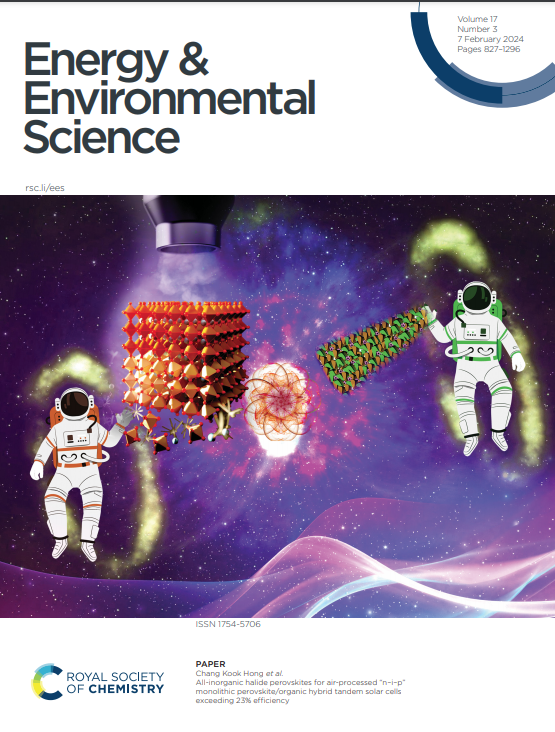Balancing the supersaturation rate and coordination capability for upscaling high-performance perovskite photovoltaics
IF 30.8
1区 材料科学
Q1 CHEMISTRY, MULTIDISCIPLINARY
引用次数: 0
Abstract
Transferring the well-established perovskite ink formulations from antisolvent spin coating to scalable deposition techniques remains a great challenge, primarily owing to the strikingly different crystallization kinetics involved in the two processes. Here, we discover that a balanced trade-off between supersaturation rate and coordination capability plays an essential role in regulating crystallization kinetics of the perovskite films deposited by scalable methods. In comparison to the commonly used DMF/DMSO solvent mixture, incorporating a small volume of NMP promotes rapid α-phase perovskite nucleation together with controllable crystal growth. Consequently, high-quality crystalline perovskite films with large grains and voids-free buried interface are readily obtained by blade coating. On these bases, inverted perovskite solar cells (0.09 cm2) and mini-modules (21.84 cm2) achieve high efficiencies of 25.38% and 23.22%, respectively. Furthermore, the unencapsulated solar cells deliver remarkable durability under maximum power point (MPP) tracking, maintaining 87% of their initial efficiency over 1000 h. This work provides an important avenue to bridge the gap between lab-scale cells to fab-scale perovskite photovoltaic modules.平衡高性能钙钛矿光伏电池的过饱和速率和配位能力
将成熟的钙钛矿油墨配方从抗溶剂旋转涂层转移到可扩展的沉积技术仍然是一个巨大的挑战,主要是由于两种工艺中涉及的结晶动力学明显不同。在这里,我们发现过饱和速率和配位能力之间的平衡在调节可扩展方法沉积的钙钛矿薄膜的结晶动力学中起着至关重要的作用。与常用的DMF/DMSO溶剂混合物相比,加入小体积的NMP促进了α相钙钛矿的快速成核和可控的晶体生长。因此,通过叶片涂覆可以获得晶粒大、界面无孔洞的高质量钙钛矿晶体薄膜。在此基础上,倒置钙钛矿太阳能电池(0.09 cm2)和迷你组件(21.84 cm2)的效率分别达到25.38%和23.22%。此外,未封装的太阳能电池在最大功率点(MPP)跟踪下具有卓越的耐久性,在1000小时内保持87%的初始效率。这项工作为弥合实验室规模电池与晶圆厂规模钙钛矿光伏组件之间的差距提供了一条重要途径。
本文章由计算机程序翻译,如有差异,请以英文原文为准。
求助全文
约1分钟内获得全文
求助全文
来源期刊

Energy & Environmental Science
化学-工程:化工
CiteScore
50.50
自引率
2.20%
发文量
349
审稿时长
2.2 months
期刊介绍:
Energy & Environmental Science, a peer-reviewed scientific journal, publishes original research and review articles covering interdisciplinary topics in the (bio)chemical and (bio)physical sciences, as well as chemical engineering disciplines. Published monthly by the Royal Society of Chemistry (RSC), a not-for-profit publisher, Energy & Environmental Science is recognized as a leading journal. It boasts an impressive impact factor of 8.500 as of 2009, ranking 8th among 140 journals in the category "Chemistry, Multidisciplinary," second among 71 journals in "Energy & Fuels," second among 128 journals in "Engineering, Chemical," and first among 181 scientific journals in "Environmental Sciences."
Energy & Environmental Science publishes various types of articles, including Research Papers (original scientific work), Review Articles, Perspectives, and Minireviews (feature review-type articles of broad interest), Communications (original scientific work of an urgent nature), Opinions (personal, often speculative viewpoints or hypotheses on current topics), and Analysis Articles (in-depth examination of energy-related issues).
 求助内容:
求助内容: 应助结果提醒方式:
应助结果提醒方式:


